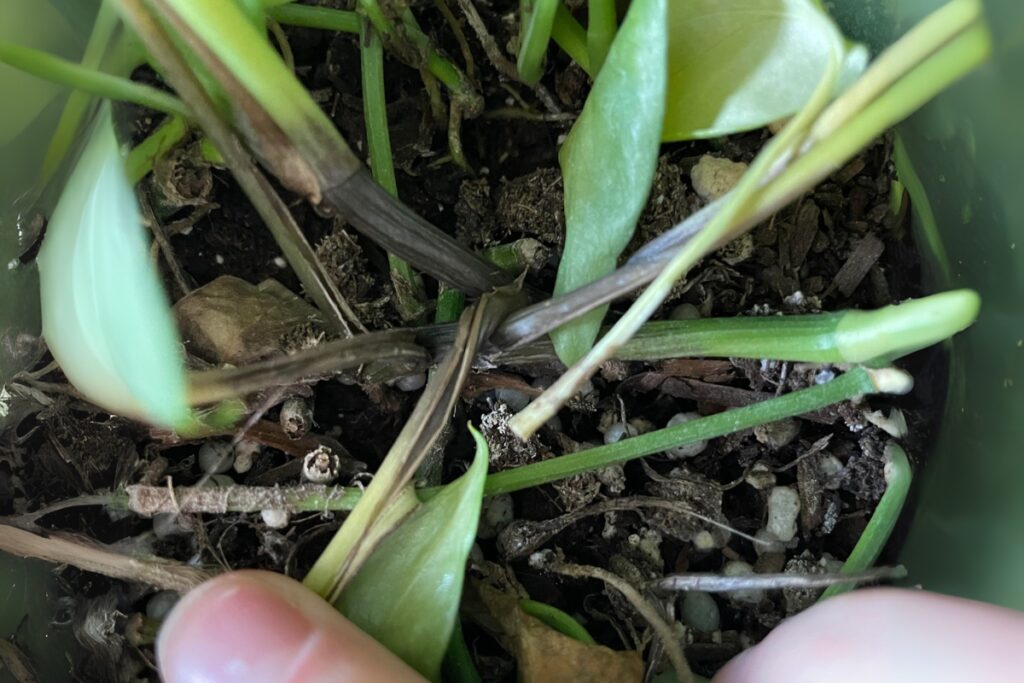Brown, mushy stems on pothos plants signal serious trouble lurking beneath the surface. Most plant owners notice these alarming symptoms too late, when root rot has already taken hold. The good news is that even severely damaged pothos can bounce back with swift, targeted intervention. However, success depends entirely on identifying the root cause quickly, whether it’s overwatering, poor drainage, or hidden pest damage that’s destroying the plant from within.

Contents
- 1 When Too Much Water Becomes the Enemy
- 2 The Silent Killer: Root Rot Detection and Treatment
- 3 Why Your Soil Choice Matters More Than You Think
- 4 Recognizing the Signs of a Thirsty Pothos
- 5 Tiny Invaders: Identifying and Eliminating Pests and Diseases
- 6 Environmental Stress Factors That Damage Your Plant
- 7 Quick Action Steps to Save Your Dying Pothos
When Too Much Water Becomes the Enemy
While pothos plants are famously forgiving, too much water quickly transforms from care into catastrophe. Overwatering creates brown, mushy stems and yellowing leaves as waterlogged roots suffocate without oxygen. The dreaded root rot follows, starting with browning at the base and spreading upward through the plant.
Proper watering frequency means letting soil dry slightly between sessions, typically every few days. This moisture balance prevents the soggy conditions that kill roots. When root rot strikes, immediate action saves the plant: trim damaged portions, repot in fresh soil, and establish a drier routine moving forward.
The Silent Killer: Root Rot Detection and Treatment

Root rot operates like a hidden assassin, destroying pothos plants from below ground while symptoms remain invisible until significant damage occurs. Early detection requires checking for mushy, brown roots and blackened stem bases during regular inspections.
When root rot strikes, immediate action saves plants. Remove the pothos from its container, trim all damaged roots back to healthy white tissue, and cut brown stems to viable growth points. Repot using fresh, well-draining soil mix in a clean container.
Preventive measures include proper watering schedules, ensuring soil dries slightly between waterings, and using appropriate drainage systems.
Why Your Soil Choice Matters More Than You Think
The foundation beneath a pothos plant determines whether it thrives or slowly deteriorates, making soil selection one of the most critical decisions for plant health. Poor soil choice creates moisture problems, leading to brown roots and compromised stems. Compacted soil blocks proper drainage and restricts oxygen flow to roots.
Soil aeration becomes essential for healthy growth, allowing roots to breathe and function properly. Well-draining soil that retains some moisture while preventing waterlogging provides the ideal balance. Understanding drainage importance helps prevent the slow decline that kills more pothos than dramatic accidents ever could.
Recognizing the Signs of a Thirsty Pothos
After addressing soil concerns, plant owners must learn to identify when their pothos needs water before damage occurs. A thirsty pothos displays telltale warnings before stems turn brown. Leaves lose their vibrant green color, appearing dull and lackluster. The foliage starts yellowing from the bottom up, signaling early signs of dehydration.
Check soil moisture every few days by inserting your finger one inch deep. Dry soil indicates immediate watering needs. Drooping stems and wilted leaves confirm dehydration has progressed. Weekly watering prevents these issues, but compacted soil may require soaking to guarantee proper moisture penetration throughout the root system.
Tiny Invaders: Identifying and Eliminating Pests and Diseases
Microscopic menaces and visible villains can wreak havoc on pothos plants, turning healthy green stems into brown, damaged tissue. Common culprits include aphids, spider mites, and scale insects that feed on plant sap and weaken stems.
For small infestations, pick off bugs manually or spray with soapy water weekly. Larger pest problems require insecticidal soap or horticultural oil applications every 5-7 days.
Fungal and bacterial diseases like blight also cause browning stems. Prune affected areas immediately using sterilized scissors. Effective pest prevention involves regular plant inspections, while proper disease management includes maintaining good air circulation and avoiding overwatering.
Environmental Stress Factors That Damage Your Plant
Temperature fluctuations and environmental conditions create silent stressors that gradually weaken pothos plants, often going unnoticed until brown stems appear. Cold exposure below 60°F stops growth entirely, while temperatures under 50°F cause severe damage to stems and leaves.
Humidity levels below 40% stress the plant, making it vulnerable to browning. Move affected plants to consistently warm areas above 60°F immediately. Increase humidity using pebble trays or humidifiers to maintain ideal moisture levels.
Monitor your plant’s environment regularly, as prevention beats treatment. Stable conditions prevent the gradual weakening that leads to brown stem problems.
Quick Action Steps to Save Your Dying Pothos
Act immediately when brown stems appear, as waiting even 24-48 hours can mean the difference between saving your pothos and losing it entirely. First, assess the soil moisture by inserting your finger two inches deep. If soggy, stop watering immediately and establish a proper watering schedule checking every 2-3 days.
Next, employ proper pruning techniques by cutting brown stems back to healthy green growth using sterilized scissors. Remove any mushy roots during inspection. Repot with fresh, well-draining soil if root rot is present, ensuring the new pot has adequate drainage holes for future health.
